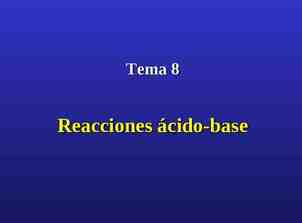Permutations and Combinations CS/APMA 202 Epp section 6.4 Aaron
21 Slides218.00 KB
Permutations and Combinations CS/APMA 202 Epp section 6.4 Aaron Bloomfield 1
Permutations vs. Combinations Both are ways to count the possibilities The difference between them is whether order matters or not Consider a poker hand: – A , 5 , 7 , 10 , K Is that the same hand as: – K , 10 , 7 , 5 , A Does the order the cards are handed out matter? – If yes, then we are dealing with permutations – If no, then we are dealing with combinations 2
Permutations A permutation is an ordered arrangement of the elements of some set S – Let S {a, b, c} – c, b, a is a permutation of S – b, c, a is a different permutation of S An r-permutation is an ordered arrangement of r elements of the set – A , 5 , 7 , 10 , K is a 5-permutation of the set of cards The notation for the number of r-permutations: P(n,r) – The poker hand is one of P(52,5) permutations 3
Permutations Number of poker hands (5 cards): – P(52,5) 52*51*50*49*48 311,875,200 Number of (initial) blackjack hands (2 cards): – P(52,2) 52*51 2,652 r-permutation notation: P(n,r) – The poker hand is one of P(52,5) permutations P(n, r ) n(n 1)(n 2).(n r 1) n! (n r )! n i i n r 1 4
r-permutations example How many ways are there for 5 people in this class to give presentations? There are 27 students in the class – P(27,5) 27*26*25*24*23 9,687,600 – Note that the order they go in does matter in this example! 5
Permutation formula proof There are n ways to choose the first element – – – – n-1 ways to choose the second n-2 ways to choose the third n-r 1 ways to choose the rth element By the product rule, that gives us: P(n,r) n(n-1)(n-2) (n-r 1) 6
Permutations vs. r-permutations r-permutations: Choosing an ordered 5 card hand is P(52,5) – When people say “permutations”, they almost always mean r-permutations But the name can refer to both Permutations: Choosing an order for all 52 cards is P(52,52) 52! – Thus, P(n,n) n! 7
Sample question How many permutations of {a, b, c, d, e, f, g} end with a? – Note that the set has 7 elements The last character must be a – The rest can be in any order Thus, we want a 6-permutation on the set {b, c, d, e, f, g} P(6,6) 6! 720 Why is it not P(7,6)? 8
Combinations What if order doesn’t matter? In poker, the following two hands are equivalent: – A , 5 , 7 , 10 , K – K , 10 , 7 , 5 , A The number of r-combinations of a set with n elements, where n is non-negative and 0 r n is: n! C (n, r ) r!(n r )! 10
Combinations example How many different poker hands are there (5 cards)? 52! 52! 52 * 51* 50 * 49 * 48 * 47! C (52,5) 2,598,960 5!(52 5)! 5!47! 5 * 4 * 3 * 2 *1* 47! How many different (initial) blackjack hands are there? 52! 52! 52 * 51 C (52,2) 1,326 2!(52 2)! 2!50! 2 *1 11
Combination formula proof Let C(52,5) be the number of ways to generate unordered poker hands The number of ordered poker hands is P(52,5) 311,875,200 The number of ways to order a single poker hand is P(5,5) 5! 120 The total number of unordered poker hands is the total number of ordered hands divided by the number of ways to order each hand Thus, C(52,5) P(52,5)/P(5,5) 12
Combination formula proof Let C(n,r) be the number of ways to generate unordered combinations The number of ordered combinations (i.e. rpermutations) is P(n,r) The number of ways to order a single one of those r-permutations P(r,r) The total number of unordered combinations is the total number of ordered combinations (i.e. rpermutations) divided by the number of ways to order each combination Thus, C(n,r) P(n,r)/P(r,r) 13
Combination formula proof P (n, r ) n! /( n r )! n! C (n, r ) P (r , r ) r! /( r r )! r!(n r )! 14
Bit strings How many bit strings of length 10 contain: a) exactly four 1’s? Find the positions of the four 1’s Does the order of these positions matter? Nope! Positions 2, 3, 5, 7 is the same as positions 7, 5, 3, 2 Thus, the answer is C(10,4) 210 b) at most four 1’s? There can be 0, 1, 2, 3, or 4 occurrences of 1 Thus, the answer is: C(10,0) C(10,1) C(10,2) C(10,3) C(10,4) 1 10 45 120 210 386 15
Bit strings How many bit strings of length 10 contain: c) at least four 1’s? There can be 4, 5, 6, 7, 8, 9, or 10 occurrences of 1 Thus, the answer is: C(10,4) C(10,5) C(10,6) C(10,7) C(10,8) C(10,9) C(10,10) 210 252 210 120 45 10 1 848 Alternative answer: subtract from 210 the number of strings with 0, 1, 2, or 3 occurrences of 1 d) an equal number of 1’s and 0’s? Thus, there must be five 0’s and five 1’s Find the positions of the five 1’s Thus, the answer is C(10,5) 252 16
Corollary 1 Let n and r be non-negative integers with r n. Then C(n,r) C(n,n-r) Proof: n! C ( n, r ) r!(n r )! n! n! C (n, n r ) (n r )! n (n r ) ! r!(n r )! 17
Corollary example There are C(52,5) ways to pick a 5-card poker hand There are C(52,47) ways to pick a 47-card hand P(52,5) 2,598,960 P(52,47) When dealing 47 cards, you are picking 5 cards to not deal – As opposed to picking 5 card to deal – Again, the order the cards are dealt in does matter 18
Combinatorial proof A combinatorial proof is a proof that uses counting arguments to prove a theorem – Rather than some other method such as algebraic techniques Essentially, show that both sides of the proof manage to count the same objects Most of the questions in this section are phrased as, “find out how many possibilities there are if ” – Instead, we could phrase each question as a theorem: – “Prove there are x possibilities if ” – The same answer could be modified to be a combinatorial proof to the theorem 19
Circular seatings How many ways are there to sit 6 people around a circular table, where seatings are considered to be the same if they can be obtained from each other by rotating the table? First, place the first person in the north-most chair – Only one possibility Then place the other 5 people – There are P(5,5) 5! 120 ways to do that By the product rule, we get 1*120 120 Alternative means to answer this: There are P(6,6) 720 ways to seat the 6 people around the table For each seating, there are 6 “rotations” of the seating Thus, the final answer is 720/6 120 20
Horse races How many ways are there for 4 horses to finish if ties are allowed? – Note that order does matter! Solution by cases – No ties The number of permutations is P(4,4) 4! 24 – Two horses tie There are C(4,2) 6 ways to choose the two horses that tie There are P(3,3) 6 ways for the “groups” to finish – A “group” is either a single horse or the two tying horses By the product rule, there are 6*6 36 possibilities for this case – Two groups of two horses tie There are C(4,2) 6 ways to choose the two winning horses The other two horses tie for second place – Three horses tie with each other There are C(4,3) 4 ways to choose the two horses that tie There are P(2,2) 2 ways for the “groups” to finish By the product rule, there are 4*2 8 possibilities for this case – All four horses tie There is only one combination for this – By the sum rule, the total is 24 36 6 8 1 75 21
A last note on combinations An alternative (and more common) way to denote an r-combination: n C (n, r ) r I’ll use C(n,r) whenever possible, as it is easier to write in PowerPoint 22


























